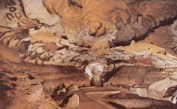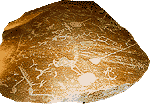
 Stone Age art or
stone age art - The first
known period of prehistoric
human culture, during which work
was done with stone tools.
The period began with the earliest human development, about 2
million years ago. It is divided into three periods:
Stone Age art or
stone age art - The first
known period of prehistoric
human culture, during which work
was done with stone tools.
The period began with the earliest human development, about 2
million years ago. It is divided into three periods:
Making generalizations about the visual culture of any group of people is a crude endeavor, especially with a culture as diverse as that of the Stone Age. With this thought in mind, know that this survey, as any must be, is tremendously limited in its breadth and depth.
Examples of Stone Age art:

Among the earliest pieces of prehistoric
sculpture that has been found is the Venus of Willendorf , c. 30,0000 - 25,000
BCE,
limestone, height
11 cm, found in lower Austria, now in Naturhistorisches Museum,
Vienna. Clearly the female reproductive anatomy
has been exagerrated, and therefore experts think it likely that
it represented a fertility
symbol, perhaps carried by a male hunter/gatherer
as a reminder of his mate back home. [Short videos of this sculpture.]

Russia, Kostenky settlement, Female Figurine,
23,000-21,000 BCE,
limestone, height
10.2 cm, Hermitage Museum, St. Petersburg, Russia.

Siberia, Malta settlement, Bird Figurine, 22nd-21st millennium
BCE,
mammoth ivory,
height 10.3 cm, Hermitage
Museum, St. Petersburg, Russia.

Cro-Magnon peoples, Cave at Lascaux, France,
"Hall
of Bulls", 15,000-13,000 BCE,
"fresco"
and
 "found
relief" includes paintings of bulls, horses, deer, bison,
etc.
"found
relief" includes paintings of bulls, horses, deer, bison,
etc.
Here is one of the horses, and a wall painted with several animals. See found material and relief.
Spain, Caves of Altamira, 15,000-12,000 BCE, paintings on the cave's wall.

China, Painted twin-jar, Yangshao culture (c.5000
- 2000 BCE),
pottery, height 20 cm, Henan
Museum, China. Unearthed at Zhengzhou, Henan. This jar was used
for drinking wine. Two people, each holding a side of the jar,
would drink simultaneously. This custom is still practiced in
various cultures today — symbolizing love and friendship.

Russia, Lake Onega, Carved
Petroglyph (fragment),
4th-3rd millennium BCE,
granite, 240 x 308 cm,
Hermitage Museum, St. Petersburg, Russia. See petroglyph.
Also see cromlech, dolmen, megalith, and monolith.
https://inform.quest/_art